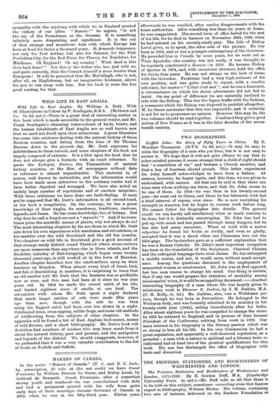WILD LIFE IN EAST ANGLIA.
Wild Life in East Anglia. By William A. DIAL With 16 Illustrations in Colour by F. Southgate, R.B.L. (Methuen and Co. 7s. 6d. net.)—There is a great deal of interesting matter in this book which is made accessible to the general reader, and Mr. Frank Southgate's charming water-colours of birds, beasts, and the human inhabitants of East Anglia are so well known now that we need not dwell upon their attractions. A great literature has come into existence dealing with the natural history of these Eastern counties, and dating from the time of Sir Thomas Browne down to the present day. Mr. Dutt expresses his indebtedness to these records, and some chapters of his book are largely composed of extracts. It is a blot upon the book that he does not always give a footnote with an exact reference. To quote the Zoologist, Nature, the Transactions of natural history societies, or the files of newspapers without date or reference is almost unpardonable. This material is, of course, well known to naturalists, and the information would have been made more attractive to the ordinary reader had it been better digested and arranged. We have also noted an unduly large number of repetitions and of careless misprints. With these criticisms we have done our fault-finding. It must not be supposed that Mr. Dutt's information is all second-hand, or his book a compilation. On the contrary, he has a great knowledge of East Anglia, its marshmen, traditions, customs, legends, and fauna. He has some knowledge, too, of botany. But why does he call a forget-me-not a " myosote " ? And if he some- times gives the scientific names of plants, why not always do so? The most interesting chapters by far are those in which Mr. Dutt sets down his own experiences with marshmen and eel-catchers, or his rambles over the wild Breckland and the old fen country. Two chapters on wild life in Breckland give a good account of that strange sandy district round Thetford where stone-curlews are more numerous than anywhere else in these islands, and the Neolithic industry of flint-knapping, which began some twenty thousand years ago, is still worked at in the town of Brandon. Another chapter describes how the smelt-netters carry on their business on Breydon. When almost every kind of beast, bird, and fish is' diminishing in numbers, it is surprising to learn that an old smelter told Mr. Dutt that the business was as profitable now as ever, and this man had been at it since he was nine years old. In 1904 he made the record catch of his life, and landed eighteen score of smelts at one haul. The eel-catcher with whom Mr. Dutt spent a night declared that much larger catches of eels were made fifty years ago than now, though with the sett he was then using his biggest catch had been over ten stones in a night. Celebrated trees, swan-upping, edible frogs, and some old methods of wildfowling form the subjects of other chapters. In the appendix will be found a list of East Anglian bird-names, names of wild flowers, and a short bibliography. Mr. Dutt's book will doubtless find numbers of readers who may learn much from it about the natural history, past and present, and the antiquities and legends of the district. We should exaggerate, however, if we pretended that it was a very valuable contribution to the list of books on Norfolk and Suffolk.






























































 Previous page
Previous page